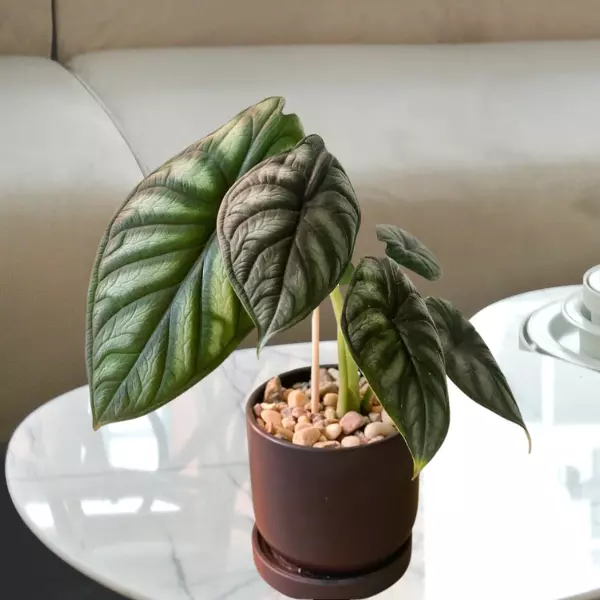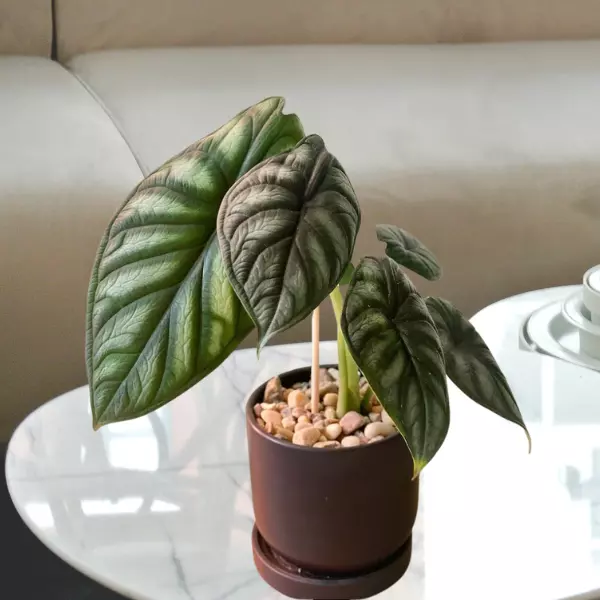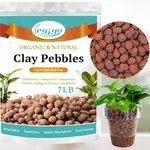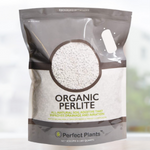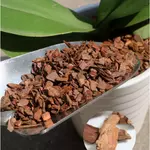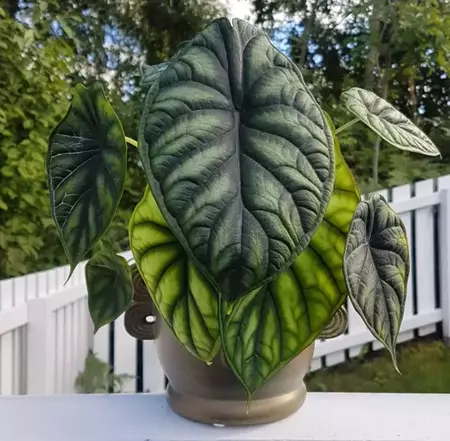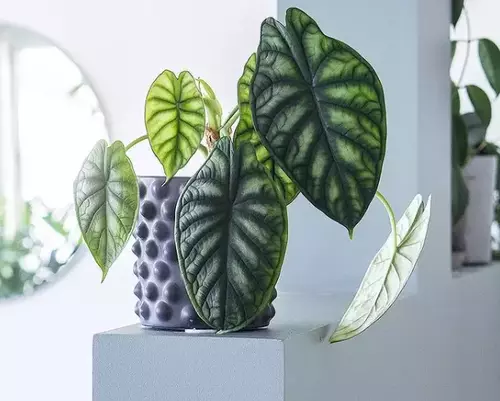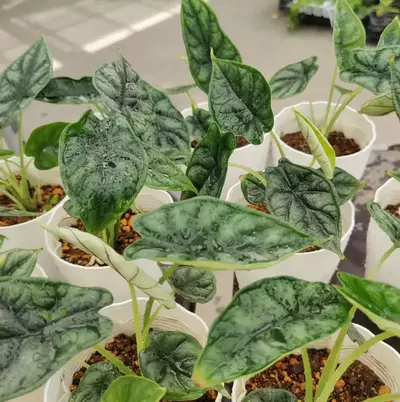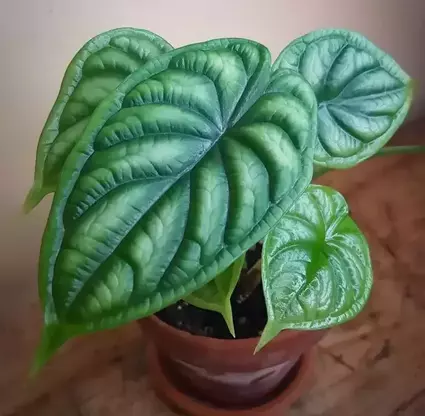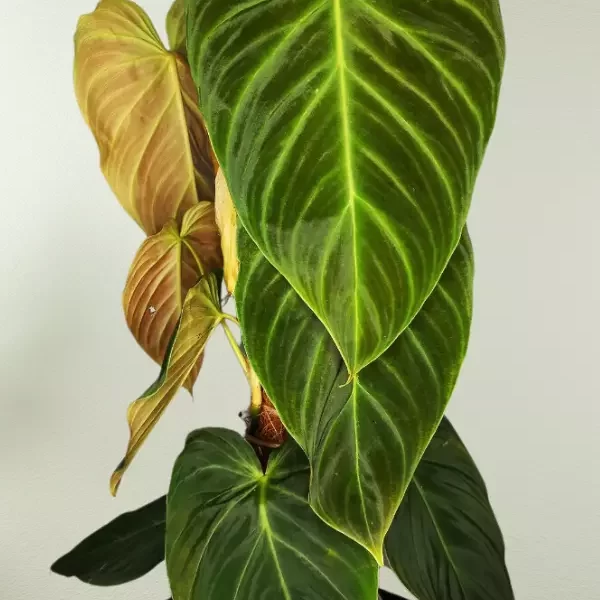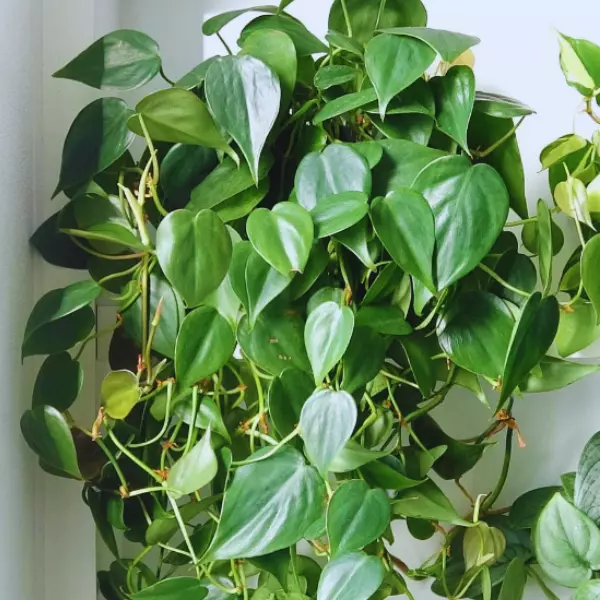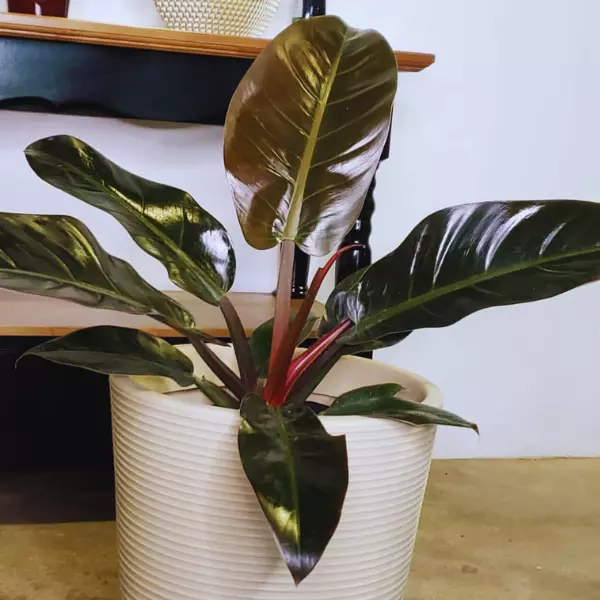Greetings Alocasia Lovers!!
Are you a staunch plant lover and looking for something exclusive and elegant? Then no need to search for anything other than Alocasia Baginda Dragon Scale- an exquisite Jewel Alocasia. This spectacular Alocasia plant is adored for its incredible textured foliage that look like the Dragon Scale. Additionally, the leaves are rigid and malleable. Because of its low growth and compact size, it’s ideal for small places, such as Ikea Green Cabinets or coffee tables. Alocasia Dragon Scale is a rare Alocasia favorite among plant collectors and lovers alike because of its striking gaze and small size.
Previously named Alocasia Baginda Dragon Scale is native to the tropical regions of south east Asia. This gorgeous evergreen plant has some challenging needs if you intend to grow it indoors. It’s less fussy than some of its relatives but still demanding compared to other houseplants. It needs a specific environment where it can thrive.
This salient plant is mainly liked for its fabulous foliage, but it also produces trivial spathe-like flowers in summer and spring.
Allied Species: Alocasia Sarian, Alocasia Pink Dragon, Alocasia Cuprea, Alocasia Lauterbachiana, Alocasia Silver Dragon, Alocasia Stingray, Alocasia Regal Shields, Alocasia Nebula, Alocasia Maharani, Alocasia Jacklyn , Alocasia Melo.
Related Products
Products | Name | Check Price |
Organic Perlite for Plants | ||
WONDER SOIL Organic | ||
Orchid Potting Bark Mulch |
Habitat & Ecology
| Botanical Name: | Alocasia Baginda ‘Dragon Scale’ |
| Family Name: | Araceae |
| Common names: | Alocasia Dragon Scale, Jewel Alocasia |
| Origin | Borneo |
| Plant Size | 2-3 ft. tall , 1-2 ft. wide |
| Plant type: | Flowering Perennial |
| Humidity: | 60%-80%. |
| Temperature: | 55F-80F |
| Light Need | Bright Indirect light |
| Soil | Moist but well-draining |
| Water | Water when the top 40% of soil is dry. |
| Pest and Diseases | Spider mites and root rot |
Alocasia Dragon Scale vs. Silver Dragon
Alocasia Dragon silver and Alocasia Dragon Scale both are variants of Alocasia Baginda. However, you can tell them apart based on their foliage. The Alocasia Silver Dragon features light gray textured leaves with ashy gray or silver markings contrasting deep green venation identical to silver dragon scales hence got the name Silver Dragon Alocasia. In contrast, Dragon Scale Alocasia exhibits rich dark green scaly textured leaves contrasting with grey or black colored veins.
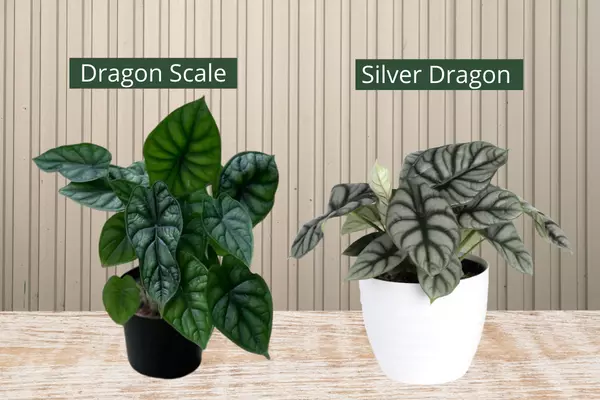
To sum up , Silver Dragon Alocasia features light grey coloured foliage whereas, Dragon scale Alocasia features dark green foliage.
How do you look after Alocasia Dragon Scale?
Dragon Scale Alocasia is considered a high-maintenance plant, but if you have grown Alocasias before then, you will have no difficulties with this unique loveliness. As they are habitual of living in tropical rainforests, try to imitate that environment at home when raising them indoors. When growing this tropical plant indoors, the most important thing to consider is the provision of enough humidity and light.
Do you find gardening stressful but also like to grow plants at home? Many people find it hectic initially, but with little help and guidance, they learn to do it perfectly. Here, in this article, we have come up with the complete care guide for the Dragon Scale Alocasia. We are sure it will help you to become a pro plant parent, even if you are just a starter.

Initial Care at Home
Alocasia Dragon Scale comes from tropical habitats and craves that environment at your home too. So when you bring this beauty home initially, try to create the same environment to keep it healthy and happy. It is a rare plant, so it can do wonders if provided the proper care. It likes a warm and humid atmosphere with indirect sunlight. Keep it where it receives the right amount of light and humidity.
When you bring this beauty home don’t forget to quarantine it for a while. Carefully inspect the leaves and look for any pests and diseases. We recommend showering this plant to eliminate any dust or potential pests.
Keep reading to know a detailed care guide for the Alocasia Dragon Scale.

Humidity and Temperature Requirements:
As Jewel Alocasia are endemic to rainforests , Baginda Dragon Scale desires high humidity levels. The question arises here: Can this plant survive in low-humid places? The answer varies, but according to some gardeners, the plant can do well in as low as 40% humidity if keeping the watering and light exceptional.
The perfect humidity level for the Dragon Scale is higher than 60%. However, if you feel the environment is running less humid for your beloved plant, consider placing a pebble tray or humidifier near the plant to reach ideal humidity levels. You can also keep your plant in a kitchen or bathroom with adequate light to attain certain levels.
As for as the temperature is concerned, 50° to 80°F is ideal for the Alocasia Dragon Scale. On the other hand, at temperatures lower than 60 degrees Fahrenheit, the dragon scale will be unhappy and hinder its growth.
Please ensure to place it in the right location, especially in winter. If the Alocasia Dragon Scale is exposed to lower temperatures, your beautiful plant can become dormant. Therefore, in the winter season, keep the room warm with the help of heaters.

How often do you water Dragon Scales?
Correct watering is essential when it comes to Alocasia’s health. They don’t like to stand in water. But Dragon Scale prefers frequent watering and doesn’t allow the soil to become dry. So before watering, please let the top two inches ( 40%) of soil dry. Always drench the soil and let the excess water drains completely.
The watering method for the soilless potting is a bit different than the regular soil. If you are using a soilless mixture for your Alocasia Dragon Scale, bottom watering is the preferable method for watering the plant. It is worth declaring to avoid overwatering the plant to evade root rot and fungal infections.
We highly recommend a moisture meter or sensor to monitor the moisture of the soil to eliminate the risk of overwatering.

Light Need
Being a tropical plant, the best lightning for the Alocasia Dragon Scale is bright but indirect as the direct sunlight scorches the foliage, and you don’t want to look at your plant as unattractive, right?
If you want it to thrive, place it near a sunny window or in filtered sunlight behind a vertical curtain. The ideal location for the plant is the 2 feet distance from the northeast-facing window. It would help if you move the plant container closer to the window in winter. Moreover Dragon Scale plant love to grow under the grow lights of Ikea Cabinets as well.
Don’t forget to rotate the plant regularly to allow balanced growth. Grow lights for this Alocasia plant is also adequate if your space doesn’t have enough sunlight. Moreover, if you keep the plant outdoors, place it in a shady spot to protect it from direct and intense light during the day to prevent burning of foliage.

Soil Requirements
Dragon Scale Alocasia loves a well-draining, airy, and chunky potting mix. However, the key to the healthy growth of the plant is the right soil mix. This plant doesn’t like dense, compact soil and is most likely to suffer from root rot. The purpose of airy chunky mix is that the roots of the plant can breath and soil holds the amount of water it needs and drains the excess.
The ideal potting mix for Dragon scale Alocasia should have equal parts of orchid bark, Coco Coir, and pumice. This soilless mixture will keep the plant healthy and happy.
- Pumice: It helps in improving the soil structure and develops drainage. It also prevents the soil from being waterlogged.
- Coco peat: It’s best for retaining soil moisture and reducing the evaporation from the soil.
- Orchid bark : Orchid bark is a premium ingredient for every soil mix as its great for drainage and aeration.
- Activated charcoal : Filter the impurities and balance the pH of the soil
- Sand: For drainage
Alternatively you can get any good aroid mix from the market if you don’t want the hassle . Some well draining potting mix recommendations are;

Repotting
Like all other Alocasias, the Dragon Scale also doesn’t like to be repotted. Repotting is a stressful event in a plant’s life that can result in leaves loss and plant dormancy. Therefore, gardeners suggest avoiding repotting until it’s categorically necessary.
When you notice the roots of the Dragon Scale are bulging out of drainage holes, it’s time to repot your plant. Spring is the best season for it.
We recommend using a one-size larger pot only as over-potting can also lead to overwatering, which is very dangerous for the plant’s health.

Propagation of Alocasia Dragon Scale
The perfect time for Alocasia Dragon Scale propagation is the growing season which is summer and spring. The promulgation of this exotic plant is easy. You can breed it using two methods.
Division Method:
When the Alocasia Dragon Scale matures, the stems come out of the central clump. Also, it might have baby plants that have emerged in the pot.
Corms Method:
The corms are like bulbs, and mature Alocasia have several corms; they absorb water and nutrients. Usually you can find these corms in the soil at the time of repotting.
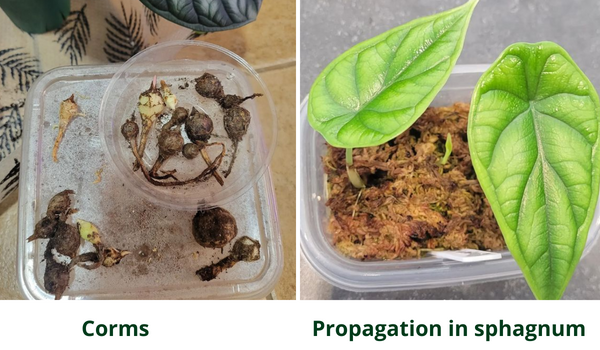

Fertilizer
Alocasias need to be fertilized, and the Dragon Scale is no exclusion. The Jewel Alocasia admires regular fertilizing and a potting mix with profusely organic materials during the growing seasons of spring and summer. Alocasia Dragon scale thrives in soil that is marginally alkaline and rich in calcium. Therefore, adding a rich in calcium fertilizer to the potting mix will provide the same rainforest conditions to the Dragon scale, which it loves. Also ensure to use a fertilizer that is nitrogen based as this is a foliage plant and nitrogen helps in the growth of beautiful foliage.
We recommend using a balanced houseplant fertilizer after every one or two months in the growing season. Moreover, adding an Osmocote slow-release fertilizer helps in the growth of the foliage.

Maintenance:
Occasional maintenance and pruning are recommended for the Dragon Scale. As it has large leaves, it tends to collect dust more often; thus, cleaning is usually required. Similarly, the old leaves will eventually die in these plants when the new leaves are growing or when the Alocasia is entering dormancy phase. If you see such leaves, simply remove them softly from the plant.
Removing dying and dead leaves and stems is the only pruning required for this plant. Trimming helps the plant to grow faster. Also, always remember to use sterile tools for pruning.

Toxicity
Alocasias are not a pet and child-friendly plants, and so is the Alocasia Dragon Scale. It contains calcium oxalate crystals that are harmful to humans and pets. If the plant is swallowed, it can cause severe irritation and disrupt the digestive system. So though this plant isn’t fatal, you can expect severe reactions from this plant.
Consequently, keep away kids and pets, and if anyone accidentally eats the plant, immediately seek medical help.

Pests and Diseases:
Pests
Pests love Alocasias, and they are more vulnerable to their bouts. The most common pests that attack this delicate plant are mealybugs, spider mites, and scale.
Immediately start the treatment if you notice any pests attacking your plant. Remove the infected parts and spray the Dragon Scale with 1 cup of rubbing alcohol and 4 cups of water mixture. Some experts also suggest using neem oil on the affected areas of the plant.
Common Problems
If grown in optimum conditions, the Alocasia Dragon scale will flourish indoors; however, if the plant requirements are not considered, it can experience some severe problems that are very common in the Dragon Scale.
Dropping Leaves: If the Alocasia Baginda drops leaves, its light, humidity, and water requirements are unmet. Analyze and check the underlying issue and provide the plant with whatever it needs for healthy growth.
Another possibility of dropping leaves is that the Alocasia dragon scale has entered dormancy. It happens mainly in the winter and fall seasons and is not very common with indoor plants. If the plant is facing dormancy, consider checking the plant’s watering needs and water it regularly until it starts to grow new buds in spring.
Yellow Leaves: If the leaves of your Dragon scale are turning yellow, it’s the indication of overwatering and root rot. Reduce the water supply in case of yellow leaves. Also, remove the affected leaves and check the roots for root rot.
Curling Leaves: It’s another problem that dragon scale faces. If the leaves of your plant are curling, it is a symptom of inadequate of humidity and moisture. Endure the regular watering and elevate the humidity levels around your plant.
Diseases
Alocasia Dragon Scale is an elusive plant and is prone to various diseases. Plants can suffer from common diseases like leaf spots and root rot.
Leaf Spot: Leaf spot is a severe condition, and the survival of a plant is tough. However, if treated in the early stage there are chances to save the plant. First of all, immediately isolate your plant and place it away from other houseplants.
After that, cut away the infected leaves with the help of sterile scissors. Leaf spot disease is caused by wet, excessively moist, and damp soil. To prevent leaf spots, don’t overwater and extremely mist your plant.
Root Rot: It’s a grave plant condition that can lead to its death. The primary root cause of rotting is usually overwatering for an extended period.
The signs of root rot are yellow leaves and black mushy patches on the plant’s stem. If you suspect your plant has root rot, remove the dragon scale from the pot and inspect the roots. If the roots are mushy and black, it’s best to cut them off.
Also, take off the soil around the roots and check the tuber because as long as the tuber is fine, you might save your plant. Finally, repot the dragon scale in a new pot with fresh soil.
Frequently Asked Questions
How big do Dragon Scale plants get?
Dragon Scale Alocasia is a fast grower, and when grown indoors in optimal conditions, it can grow 2-3 feet tall and 1- 2 feet wide. However, it can reach three to six feet tall in the wild.
Is the Alocasia Dragon Scale rare?
Sometimes Alocasia Dragon Scale plants are hard to find and are considered rare. Plant collectors adore and collect these stunning foliage plants for their rarity and exotic foliage.
Does Alocasia dragon scale like misting?
Alocasia Dragon Scale grows in rainforests and prefers moist, humid environments for thriving. However, misting its foliage to elevate the humidity is not recommended because the foliage is susceptible to fungal spots. You can provide high humidity to your Dragon Scale plant by using a plant humidifier and placing it in Ikea green cabinet, kitchen, or bathroom.
Do Alocasia Dragon Scales dormant?
Like other house plants, Alocasia Dragon Scale goes dormant during winter and grows slowly. But sometimes, it tends to go dormant during growing seasons such as Spring and summer, provided the optimal conditions. This is common with Alocasia plants.
Why are the leaves on my Alocasia Dragon Scale discolored?
Alocasia Dragon scale is very sensitive to impurities in water, so maybe high levels of fluoride and other minerals cause leaf discoloration. This is common in areas with hard water. It’s always best to use rain or distilled water for your plant.
Why my Alocasia Dragon Scale is dying?
Multiple factors cause your plant to die. Firstly, check the water, sunlight, and humidity to see if something isn’t right. Then check the signs of root rot and pests. For example, if your plant has yellow leaves and black mushy spots on the stem, it has root rot. Holes and yellow patches on the back side of the leaves indicate the pests have attacked the plant.
Immediate treatment of these issues is required because it will kill your dragon scale if left untreated.
Can I mist my Alocasia Dragon Scale?
Although the Alocasia Dragon scale likes a moist and humid environment, misting is still not a good idea to increase the humidity should be avoided. Using a humidifier or pebble tray near it or moving it to a humid room of the house are the recommended actions to provide sufficient moisture to the dragon scale.
Why are the tips of my Alocasia Dragon Scale turning brown?
Brown tips are caused by a deficiency of humidity and can happen to most houseplants. If you spot brown tips on the leaves of your plant, try increasing the humidity.
Final Words
Alocasia Dragon scale is a terrific emerald green plant with noticeable strips. This plant is adored by gardeners and houseplant lovers equally because of its unusual foliage. Although it requires some maintenance, it’s easy to grow and care for.
This glorious plant is native to tropical rainforests and prefers a humid and warm environment. If you want your plant to flourish and add to the charm of your home, ensure suitable growing conditions.
It’s hard to say which is the most crucial aspect of Alocasia Dragon scale care, but the plant certainly shows sturdy growth when it remains in good condition.
We hope that after reading this article about dragon scale exquisiteness, you will not be able to resist bringing this beauty home.
Happy Parenting Jewel Alocasia!
Related Posts
Philodendron Melanochrysum Care & Growing Guide
Philodendron ‘Splendid’ is a stunning hybrid of two stunning species of the Araceae family: Philodendron Melanochrysum and Verrucosum.
Philodendron Burle Marx Care & Propagation Guide
The most notable feature of the Philodendron Burle Marx is its large, glossy leaves, which come in heart-shaped or arrow-shaped variations.
Philodendron Scandens-“Sweetheart Plant” Easy Care Tips
Philodendron Scandens, often called the “Heartleaf Philodendron” or the “Sweetheart Plant” is a classic and most loved trailing houseplant.
Philodendron Erubescens ‘Imperial Red’ Care Tips
The Imperial Red Philodendron is easy to grow and can thrive well with little care and attention. Botanically known as Philodendron Erubescens.
Philodendron Ring of Fire Care & Growing Tips
Philodendron Ring of Fire is a striking plant known for its vibrant foliage and is believed a hybrid of Philodendron Wendlandii and P.Tortum.

